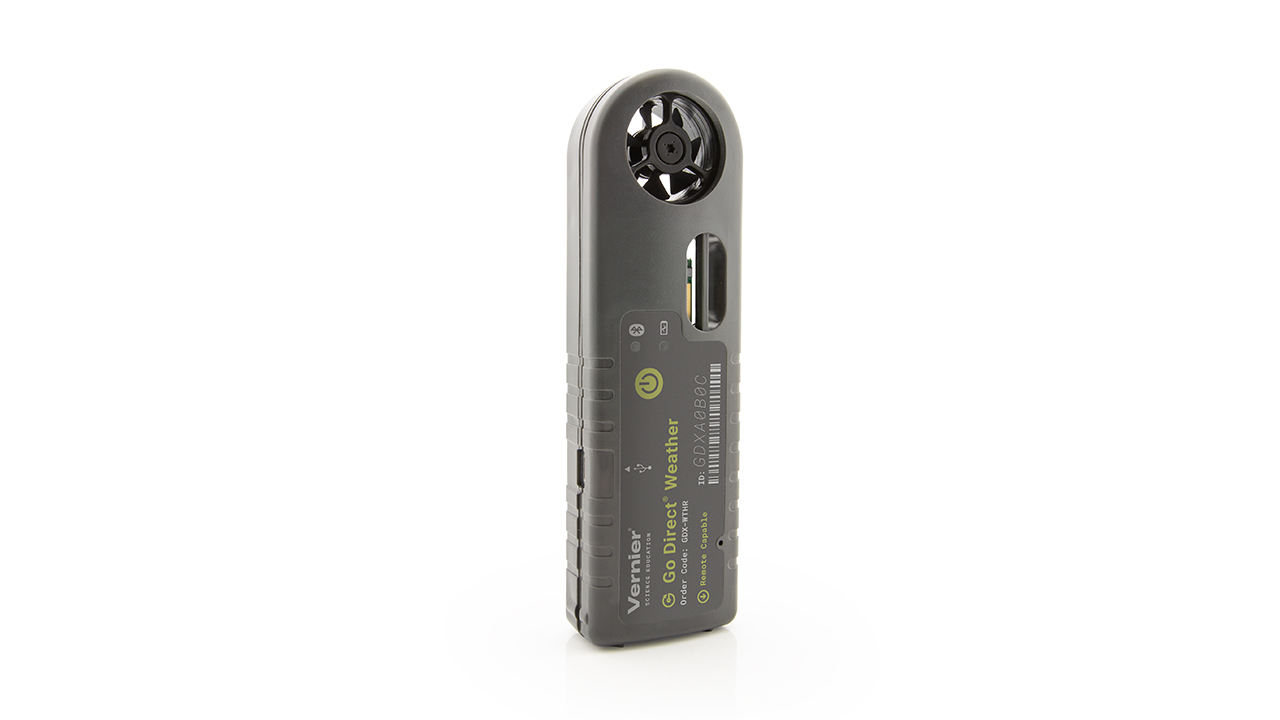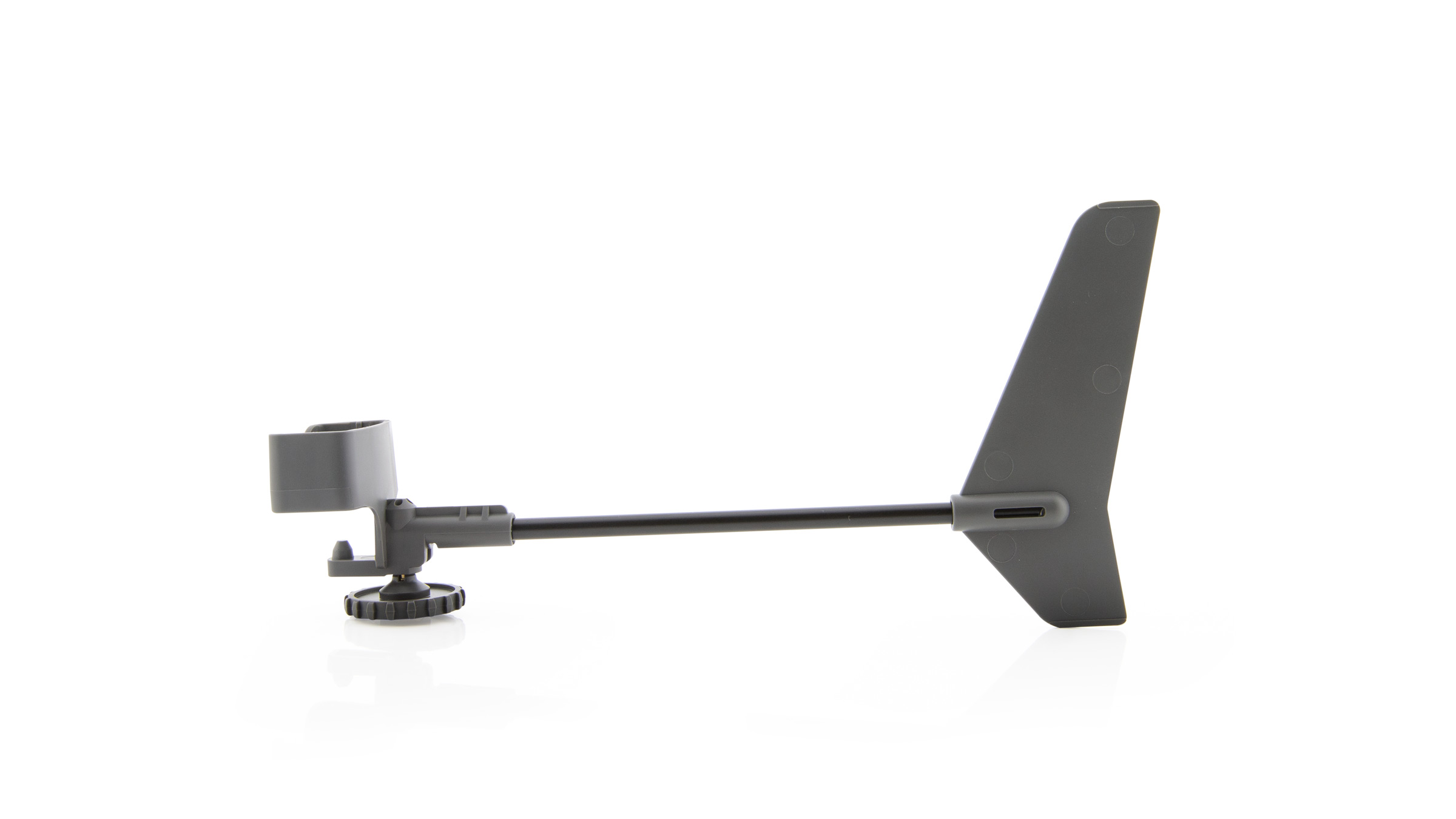

Some versions of this sensor support Remote Data Logging.
Which Go Direct Weather sensor do I have? Does it support Remote Data Logging?
Troubleshooting
General: Press the power button on the sensor to turn it on. Connect your sensor as described in the Getting Started instructions for your device.
- Primary Test: Blow onto the sensor to make sure the readings change and that the impeller spins freely.
Additional Troubleshooting
- How do I set the magnetic declination for my Go Direct Weather?
- Why doesn't my Barometer show the same pressure as the weather report?
- What size mount do I need for Go Direct Weather?
REMOTE DATA LOGGING
- Which Go Direct Weather sensor do I have? Does it support Remote Data Logging?
- Is there a way to update Go Direct sensors with the remote data logging feature?
- Remote Data Logging Troubleshooting and FAQs
- How long will my battery last for my remote data logging experiment?
- Which sensors are equipped with the remote data logging feature?
- How do I configure multiple channels of my Go Direct device for remote data logging?
- How do I start a remote data logging experiment on a triggering event?
- How do I check the status of my sensor during a remote data logging experiment?
- How do I bring remote logging data from multiple devices or multiple runs into a single Graphical Analysis file?
Specifications
- Wind speed range: 0 to 30 m/s
- Temperature range: –40 to 120°C
- Temperature accuracy: ±0.2°C
- Humidity range: 0 to 100%
- Humidity accuracy: ±2%
- Absolute pressure range: 260 to 1260 mbar
- Absolute pressure accuracy: ±0.2 mbar
- Maximum sampling rate: 2 sample/s
- Tripod Mount Requirements
⚬ Threading: ¼ – 20
⚬ Exposed Thread: 0.2 to 0.5 inch - Connections
⚬ Wireless: Bluetooth® v4.2 (wireless range 30 m unobstructed)
⚬ Wired: USB 2.0 full speed - Battery: 650 mAh Li-Poly
⚬ Battery Life (single, full charge): ~24 hours continuous data collection
⚬ Battery Life (lifetime): 2 – 5 years (typical)
Calibration
Wind Direction, Barometric Pressure, and Altitude sensors channels are dependent on location so do require a calibration to correct the readings. All other channels on this sensor are factory calibrated and cannot be calibrated by the user.
WIND DIRECTION
This channel has been factory calibrated but users might find readings to be incorrect due to interference from nearby metal objects. If that is the case, then the channel should be calibrated to offset for this interference. Follow the steps below to calibrate this sensor.
- Place the Go Direct Weather in the Weather Vane (required when using this sensor channel).
- Launch the app, connect the sensor, and turn on the Wind Direction channel, if not already enabled.
- Click or tap the Wind Direction meter and choose Calibrate.
- Click or tap Calibrate Now and slowly rotate the sensor 10 times or stop when the calibration process ends automatically.
- Click or tap Done or OK.
To display directions relative to True North, the magnetic declination of your location must be entered. See How do I set the magnetic declination for my Go Direct Weather?
BAROMETRIC PRESSURE
To accurately report barometric pressure, this channel needs to know your current elevation. This only needs to be done once if you are not changing elevations. Each time you move to a different elevation, this channel will need to be adjusted with a calibration. To enter your current elevation, follow these instructions.
- Launch the app, connect the sensor, and turn on the Barometric Pressure channel, if not already enabled.
- Click or tap the Barometric Pressure meter and choose Calibrate.
- Enter your elevation in meters. Click or tap Keep.
- Click or tap Apply.
ALTITUDE
This channel needs to be initially calibrated to your current altitude.
- Launch the app, connect the sensor, and turn on the Altitude channel, if not already enabled.
- Click or tap the Altitude meter and choose Calibrate.
- Enter your altitude in meters. Click or tap Keep.
- Click or tap Apply.
Battery Troubleshooting
- If the sensor won’t turn when on its own, but does when connected to a USB power source, try charging the sensor for at least 2 hours using a known-to-work USB cable.
- If you continue to have trouble, try swapping the battery with a working sensor to see if the problem follows the battery or stays with the sensor.
⚬ If the problem stays with the sensor, the battery is probably not the issue.
⚬ If the problem follows the battery, the battery has likely reached its end of life. - If the battery is indeed at the end of its life, the battery should be replaced.
Go Direct® 650 mAh Replacement Battery (GDX-BAT-650 ) - See How do I remove or replace a Go Direct battery? for more information.
Rechargeable batteries are covered by a one-year warranty.
Batteries should last two to five years in typical use.
Related Products
- Micro USB to USB-C Cable (
CB-USB-C-MICRO ) - Go Direct® Charge Station (
GDX-CRG ) - Go Direct® Weather Vane (
WTHR-VANE ) - Anemometer (
ANM-BTA )
Replacement Parts
- Go Direct® 650 mAh Replacement Battery (
GDX-BAT-650 ) - Micro USB Cable (
CB-USB-MICRO )
